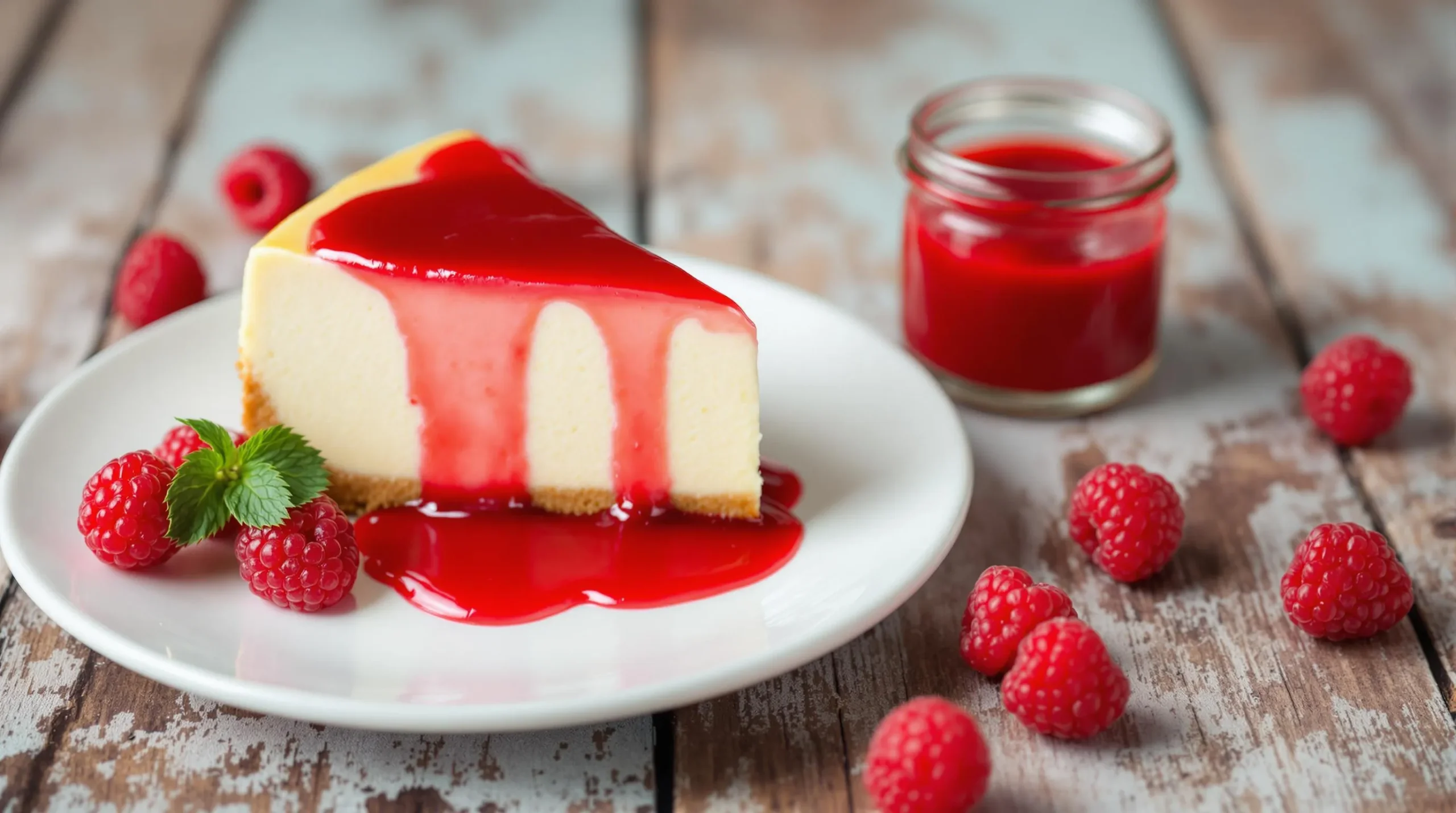Why This Raspberry Sauce Recipe Is Perfect for Any Dessert
This raspberry sauce recipe stands out as the ultimate dessert companion for several compelling reasons. Its versatility allows you to drizzle it over virtually any sweet treat from cheesecake to vanilla ice cream with equally delicious results.
The perfect balance of sweetness and tartness makes this sauce unique among dessert toppings. Unlike store-bought alternatives that often taste artificial or overly sweet, this homemade version delivers authentic raspberry flavor that lets the natural characteristics of the fruit shine through.
Texture plays a crucial role in its universal appeal. The sauce maintains a pourable consistency that’s neither too runny nor too thick, allowing it to coat desserts beautifully without overwhelming them. You can easily adjust the thickness by simmering longer for a more concentrated sauce or adding a touch more water for a lighter drizzle.
Preparation simplicity cannot be overstated. With just a handful of ingredients and minimal cooking time, you can create this impressive sauce even when entertaining guests. The recipe works perfectly with both fresh raspberries when in season and frozen berries year-round, giving you flexibility regardless of when the craving strikes.
Visual appeal adds another dimension to its perfection. The vibrant ruby-red color instantly elevates the presentation of any dessert, transforming even the simplest vanilla ice cream into an Instagram-worthy creation. This natural food coloring effect comes without any artificial additives.
Storage convenience rounds out its advantages. The sauce keeps well in the refrigerator for up to a week, allowing you to prepare it ahead of time for special occasions or enjoy it gradually with different desserts throughout the week.
Ingredients You’ll Need for Homemade Raspberry Sauce
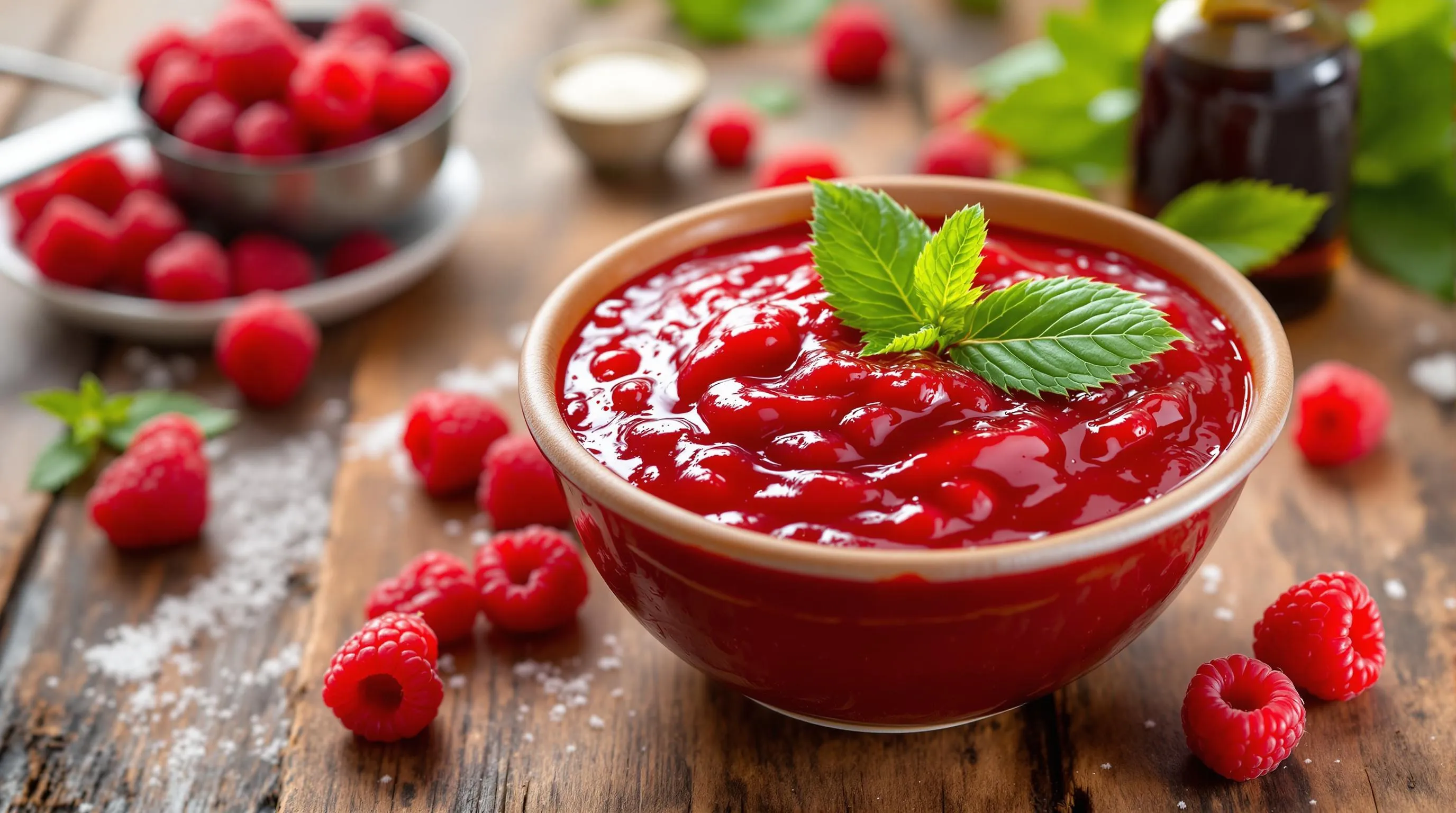
Creating this vibrant raspberry sauce requires just a handful of simple ingredients that work together to achieve that perfect sweet-tart balance. The beauty of this recipe lies in its simplicity while delivering maximum flavor.
Fresh vs. Frozen Raspberries
- 2 cups raspberries (fresh or frozen)
Fresh raspberries offer the brightest flavor and work beautifully when they’re in season during summer months. Their natural sweetness and juiciness create a sauce with exceptional fresh flavor notes. Frozen raspberries serve as an excellent year-round alternative without compromising quality. They actually break down more easily during cooking which can create a smoother consistency with less straining effort. No need to thaw frozen berries before using—simply add them directly to your saucepan and adjust your cooking time slightly. Both options yield delicious results so choose based on availability and preference.
Sweetener Options
- ¼ to ½ cup granulated sugar (adjust to taste)
- 1 tablespoon lemon juice
- ½ teaspoon vanilla extract (optional)
Granulated sugar serves as the traditional sweetener for raspberry sauce providing the perfect balance to the natural tartness of the berries. You might prefer alternatives like honey which adds floral notes or maple syrup for a deeper caramel-like sweetness. Agave nectar works well for those seeking a lower glycemic option. The amount needed varies depending on your berries’ natural sweetness and your personal preference. Start with less as you can always add more to taste. Lemon juice brightens the flavor and helps preserve the vibrant color while vanilla extract adds warmth and complexity to the finished sauce. These supporting ingredients enhance the raspberry flavor without overpowering the star of the show.
Equipment Needed
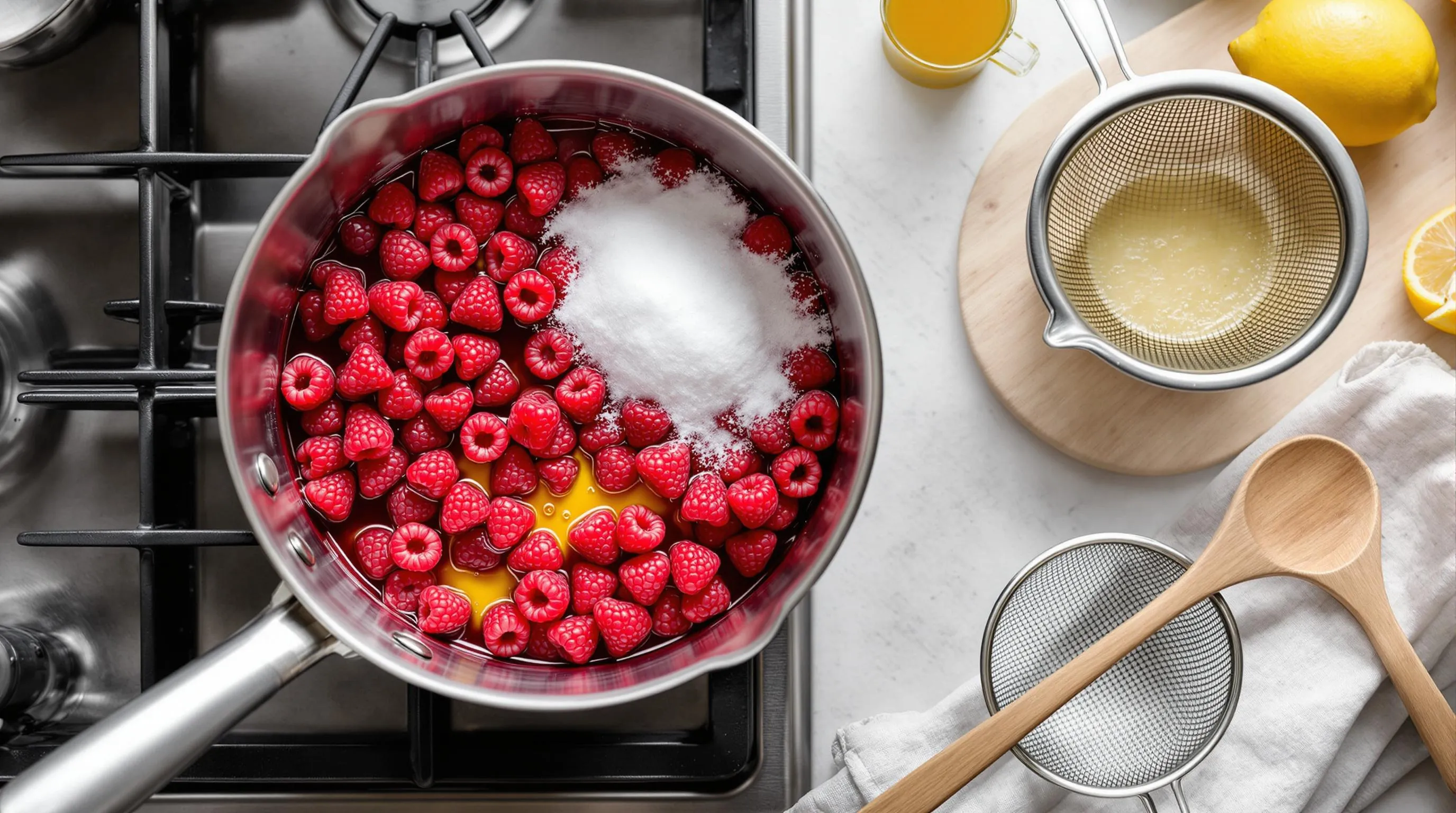
Creating this luscious raspberry sauce requires minimal kitchen equipment, making it accessible for cooks of all skill levels. Here’s what you’ll need to prepare this vibrant topping:
- Medium saucepan – For cooking the raspberries with sugar and lemon juice
- Wooden spoon or silicone spatula – To stir the sauce and prevent burning
- Fine-mesh strainer – Essential for removing seeds if you prefer a smooth sauce
- Bowl – To catch the strained sauce
- Measuring cups and spoons – For accurate ingredient measurements
- Rubber spatula – Helps press the sauce through the strainer to extract maximum flavor
- Glass jar or airtight container – For storing leftover sauce in the refrigerator
You likely already have most of these items in your kitchen. The fine-mesh strainer is particularly important if you want a silky-smooth sauce without seeds. For those who enjoy a more rustic texture, you can skip the straining step entirely and enjoy the sauce with the natural raspberry seeds intact.
How to Make Raspberry Sauce
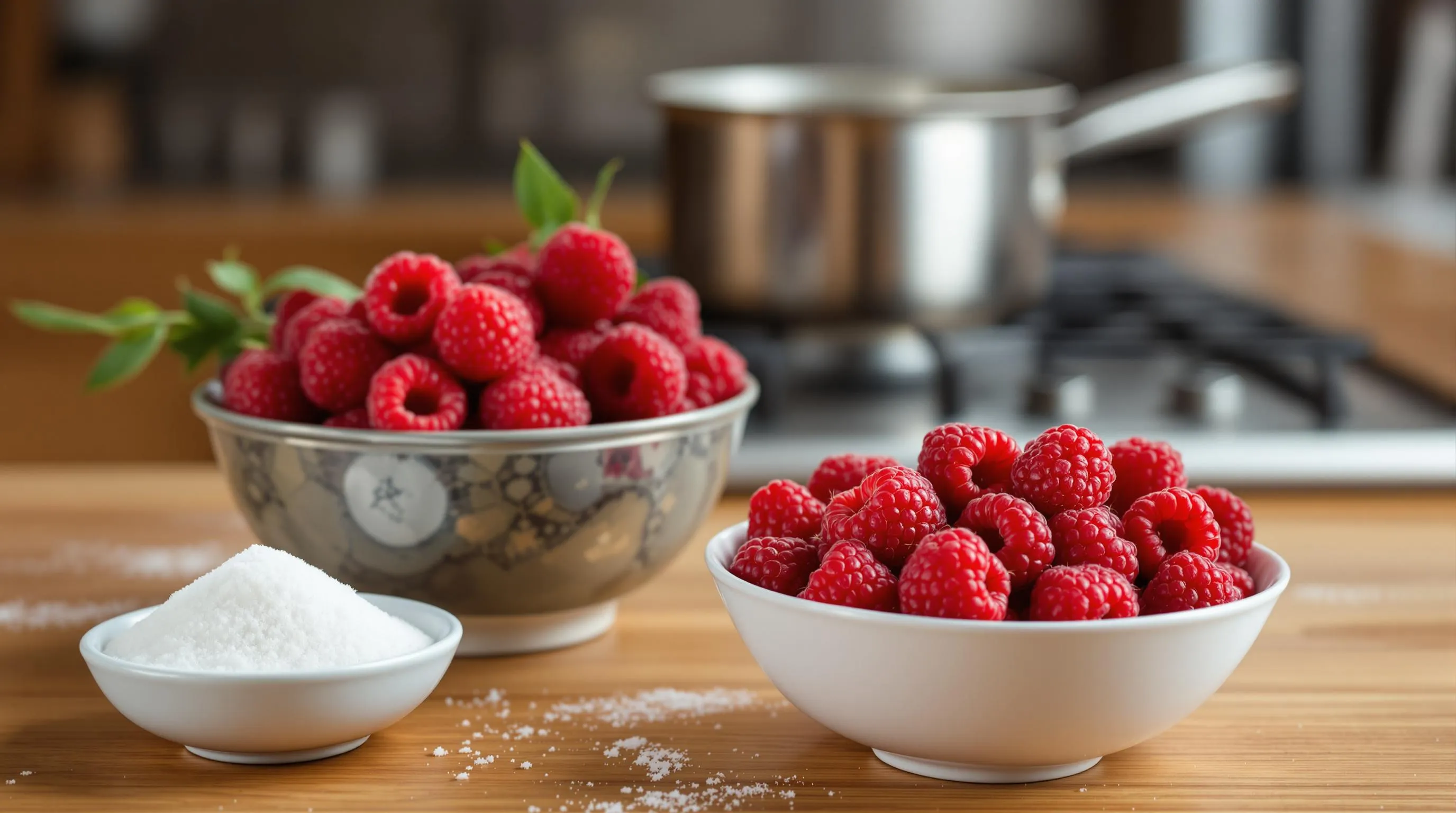
Creating this vibrant sauce requires just a few simple steps. Follow this straightforward process to transform basic ingredients into a versatile raspberry topping that will elevate your desserts.
Preparing the Raspberries
Start by rinsing fresh raspberries under cold water to remove any dirt or debris. Pat them dry gently with paper towels to prevent excess water from diluting your sauce. For frozen raspberries, allow them to thaw slightly at room temperature for about 5-10 minutes before using. Measure out your 2 cups of berries and place them in a medium bowl. Inspect the berries and remove any stems or leaves that might remain. Add your measured sugar directly to the berries now rather than during cooking for more even distribution. Squeeze your fresh lemon juice and add it to the berry mixture, stirring gently to combine without crushing the delicate fruit.
Cooking the Sauce
Transfer your raspberry mixture to a medium saucepan and place it over medium heat. Stir occasionally with a wooden spoon or silicone spatula as the berries begin to release their juices. Bring the mixture to a gentle simmer, then reduce the heat to medium-low. Allow the sauce to simmer for 5-7 minutes, stirring frequently to prevent sticking or burning. You’ll notice the raspberries breaking down naturally as they cook. Mash some berries against the side of the pan with your spoon to help them release more juice and create texture. The sauce is ready when it slightly thickens and coats the back of a spoon. Remove from heat and stir in vanilla extract if using. Let the sauce cool for about 10 minutes before deciding whether to strain it.
Straining Options (Seeds or No Seeds)
Decide whether you prefer a smooth sauce or one with natural texture. For a silky-smooth consistency, place your fine-mesh strainer over a bowl and pour the warm sauce into it. Use a rubber spatula to press the sauce through the strainer, extracting maximum flavor while leaving the seeds behind. This process takes about 2-3 minutes of gentle pressing. The strained sauce will have an elegant, velvety texture perfect for drizzling over cheesecake or ice cream. For a more rustic presentation with added texture, skip the straining step entirely. The natural seeds provide visual interest and a subtle crunch that works beautifully with pancakes, waffles, and yogurt parfaits. Your finished sauce can be used immediately while still warm or transferred to a glass jar for cooling and storage.
Tips for the Perfect Raspberry Sauce
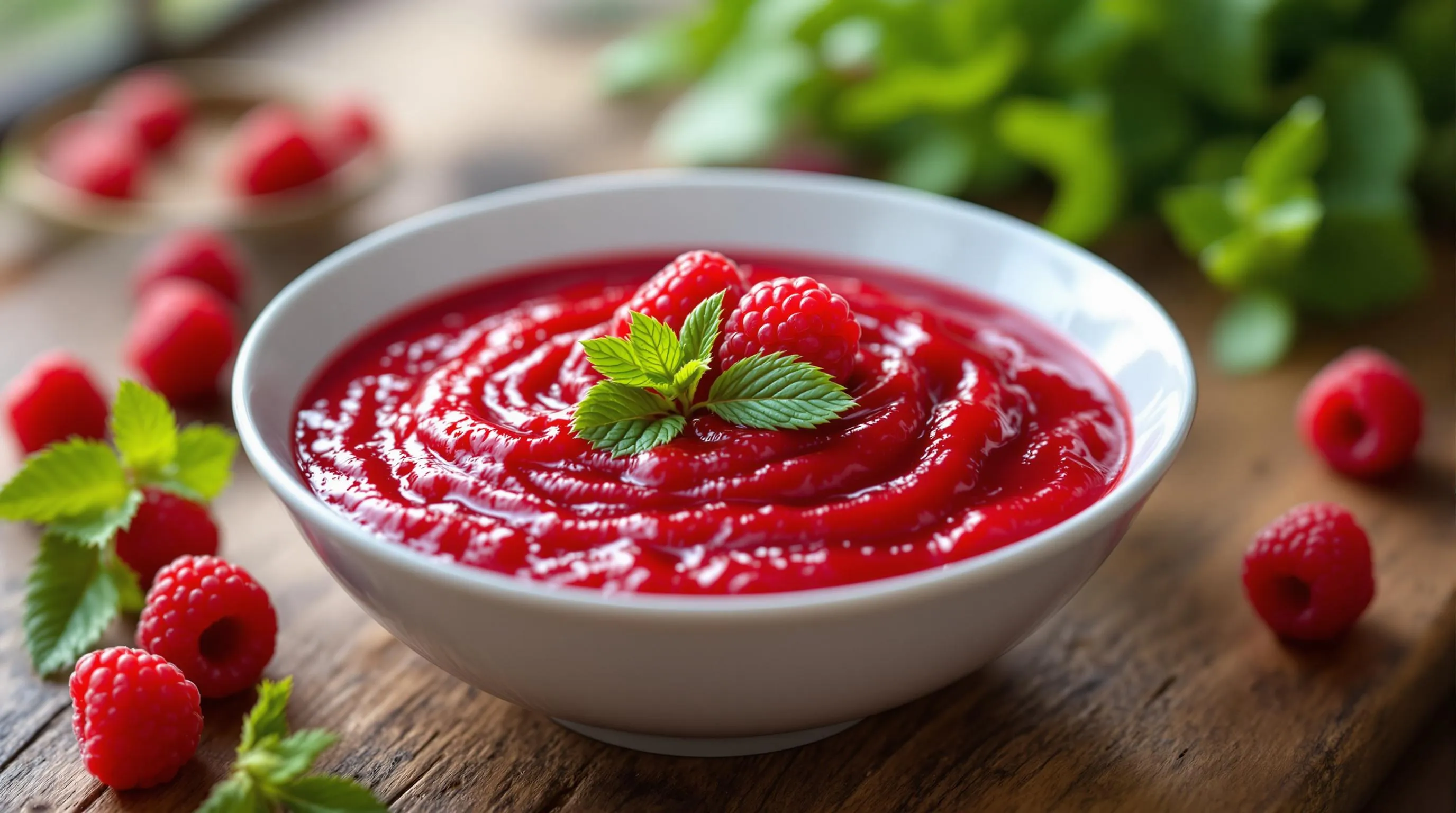
Elevate your raspberry sauce from good to exceptional with these professional techniques. These tips will help you achieve restaurant-quality results every time you make this versatile sauce.
Achieving the Right Consistency
Control the thickness of your raspberry sauce by adjusting your cooking time and technique. For a thinner sauce perfect for drizzling over pancakes or waffles, reduce your simmering time to about 5-7 minutes. When making a thicker sauce ideal for topping cheesecakes or layering in parfaits, extend the cooking time to 10-12 minutes allowing more moisture to evaporate.
Test your sauce consistency by running a finger along the back of your coated spoon—if it leaves a clear path that doesn’t immediately fill in, your sauce has reached the perfect thickness. Adding a small amount (½ teaspoon) of cornstarch mixed with cold water can provide additional thickening if needed without altering the flavor profile.
Remember that your sauce will thicken further as it cools, so remove it from heat when it appears slightly thinner than your desired final consistency. For ultra-smooth results, press the sauce gently through your strainer rather than forcing it, which prevents bitter seed fragments from passing through.
Flavor Variations
Customize your raspberry sauce with complementary flavor additions that transform this versatile base recipe. Infuse warm spices like cinnamon or cardamom (¼ teaspoon) during cooking for a cozy twist perfect for fall and winter desserts. Add 2-3 tablespoons of liqueurs such as Grand Marnier, Chambord, or amaretto after removing from heat for sophisticated adult variations.
Blend in other berries to create exciting flavor combinations—try equal parts raspberries and blackberries for a deeper berry profile or mix with strawberries for a sweeter sauce. Fresh herbs offer unexpected freshness—mint, basil, or thyme (1 tablespoon finely chopped) can be added during the final minute of cooking for a gourmet touch.
For chocolate-raspberry lovers, stir in 2 tablespoons of unsweetened cocoa powder or 1 ounce of melted dark chocolate after straining for a decadent sauce that pairs wonderfully with vanilla ice cream. Balance flavors by adding an extra pinch of salt if your sauce tastes too sweet or a drizzle more honey if it’s too tart.
Storage and Make-Ahead Instructions
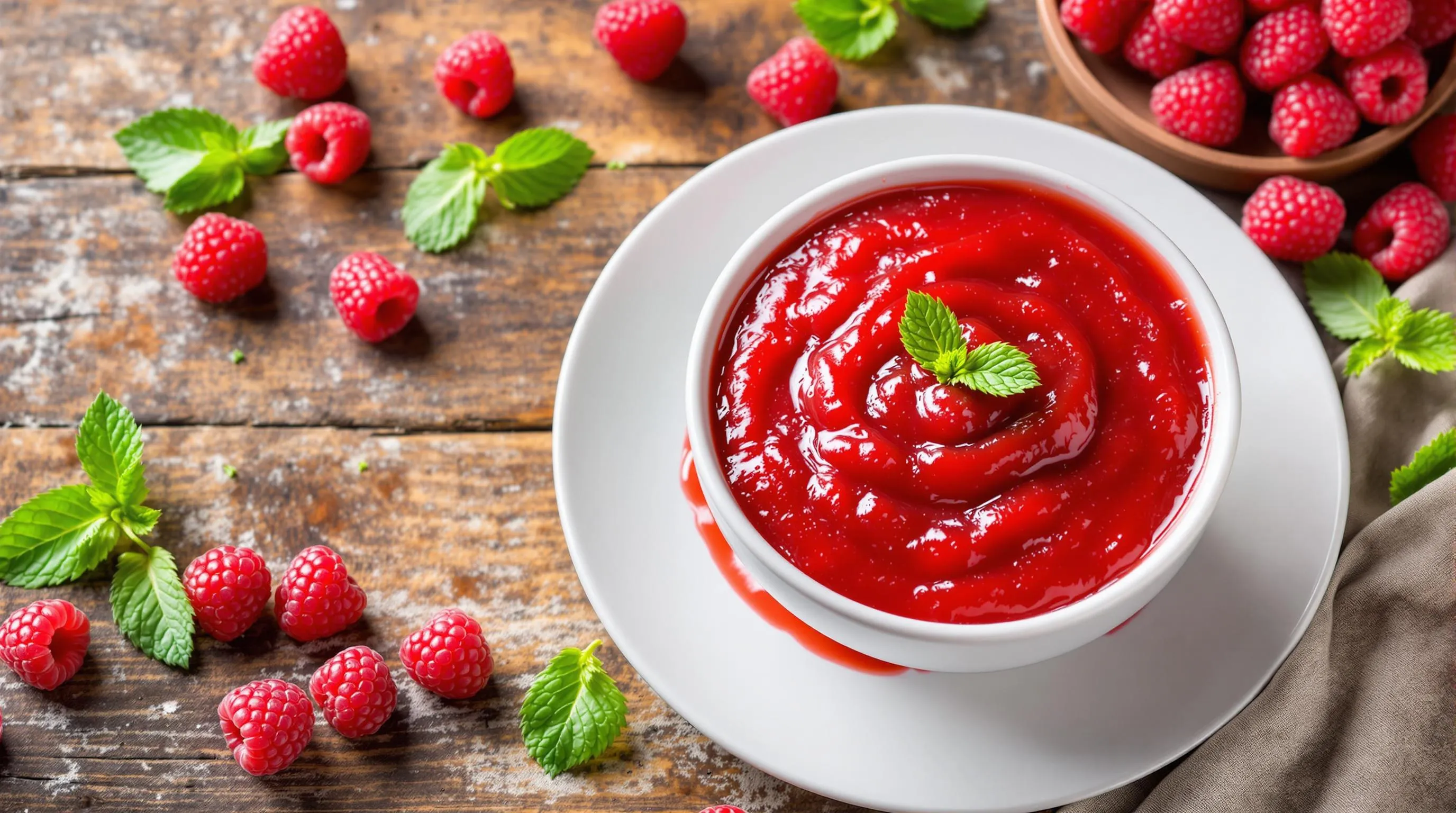
This raspberry sauce is perfect for making ahead of time as it stores beautifully. Knowing the proper storage techniques will help you enjoy your homemade sauce whenever the craving strikes.
Refrigerating Your Sauce
Store your freshly made raspberry sauce in an airtight container or glass jar in the refrigerator for up to 7 days. The sauce will naturally thicken slightly when chilled which makes it perfect for drizzling over desserts straight from the fridge. Before using refrigerated sauce allow it to sit at room temperature for about 10-15 minutes to take the chill off and enhance its flavor. You might notice a thin skin forming on top after refrigeration simply stir the sauce to reincorporate everything before serving. The bright flavor and vibrant color will remain intact throughout the storage period making this sauce an excellent prep-ahead option for dinner parties or holiday gatherings.
Freezing for Later Use
Freeze raspberry sauce in airtight containers or heavy-duty freezer bags for up to 3 months. Leave about ½ inch of headspace in containers as the sauce will expand slightly when frozen. Portion the sauce into smaller containers or ice cube trays for convenient single-serving sizes that can be thawed individually. Thaw frozen sauce overnight in the refrigerator for the best results and texture preservation. After thawing give the sauce a good stir to recombine any separated liquids. The sauce may appear slightly watery after freezing but a quick simmer on the stovetop for 1-2 minutes will help restore its original consistency. Freezing works particularly well for preserving summer berries at their peak so you can enjoy homemade raspberry sauce year-round.
Serving Suggestions
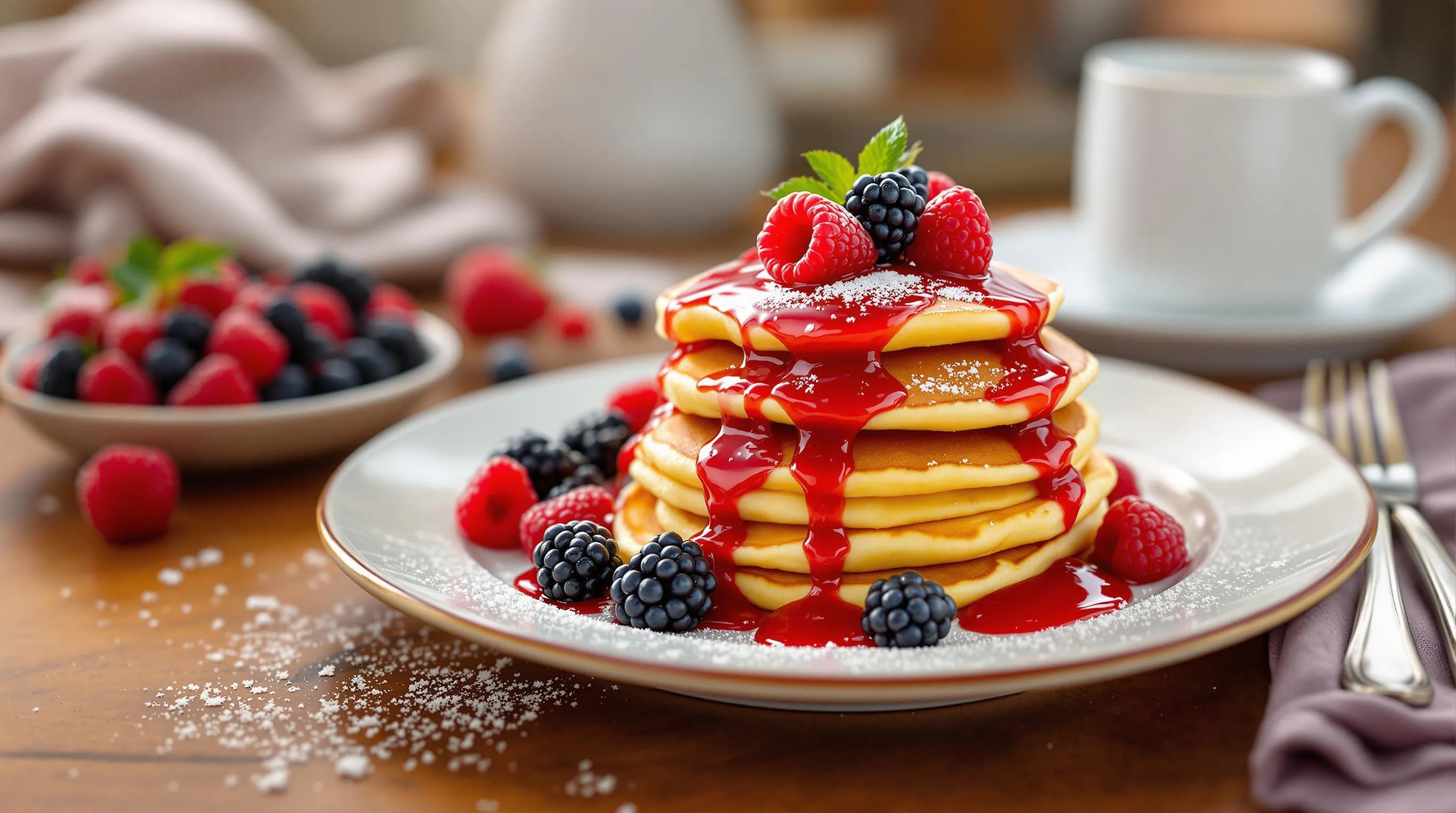
This versatile raspberry sauce elevates countless dishes with its vibrant color and perfect balance of sweet and tart flavors. Discover the many delicious ways to incorporate this ruby-red delight into your culinary creations.
Dessert Pairings
Transform ordinary desserts into extraordinary treats with a drizzle of homemade raspberry sauce. Pour it over vanilla ice cream for a classic combination that never disappoints. The sauce creates a stunning presentation when drizzled over cheesecake, adding both visual appeal and a tangy contrast to the rich creaminess.
White chocolate desserts particularly benefit from raspberry sauce, as the bright acidity cuts through the sweetness for a balanced flavor profile. Try it with panna cotta, vanilla pudding, or crème brûlée to add color and a fresh fruit element. The sauce also works beautifully with chocolate treats like brownies or chocolate cake, creating a sophisticated flavor pairing reminiscent of high-end desserts.
For entertaining, serve raspberry sauce alongside a pound cake or angel food cake, allowing guests to add as much or as little as they prefer. Dress up store-bought desserts like plain cheesecake or vanilla ice cream with this homemade sauce for an impressive yet effortless finishing touch. You’ll find it pairs wonderfully with lemon desserts too, improving the citrus notes while adding beautiful color contrast.
Breakfast Applications
Start your day with a touch of raspberry elegance by incorporating this versatile sauce into your morning routine. Drizzle it over pancakes or waffles instead of maple syrup for a fruity alternative that brings bright flavor and visual appeal to your breakfast plate.
Yogurt parfaits reach new heights when layered with raspberry sauce, granola, and fresh berries. The sauce adds natural sweetness and vibrant color that makes morning meals more enticing. Swirl it into oatmeal or cream of wheat for a nutritious breakfast with a touch of indulgence.
French toast benefits tremendously from raspberry sauce, creating a restaurant-quality dish with minimal effort. Use it to top crepes along with a dollop of whipped cream for a breakfast that feels like dessert. Blend the sauce into smoothies or smoothie bowls for added flavor and nutritional benefits.
For weekend brunches, serve the sauce alongside a selection of breakfast pastries like scones, muffins, or croissants. It makes a wonderful addition to a breakfast charcuterie board, providing a sweet component that pairs with both sweet and savory elements. Your homemade raspberry sauce will elevate everyday breakfast items into special morning treats worth waking up for.
Troubleshooting Your Raspberry Sauce
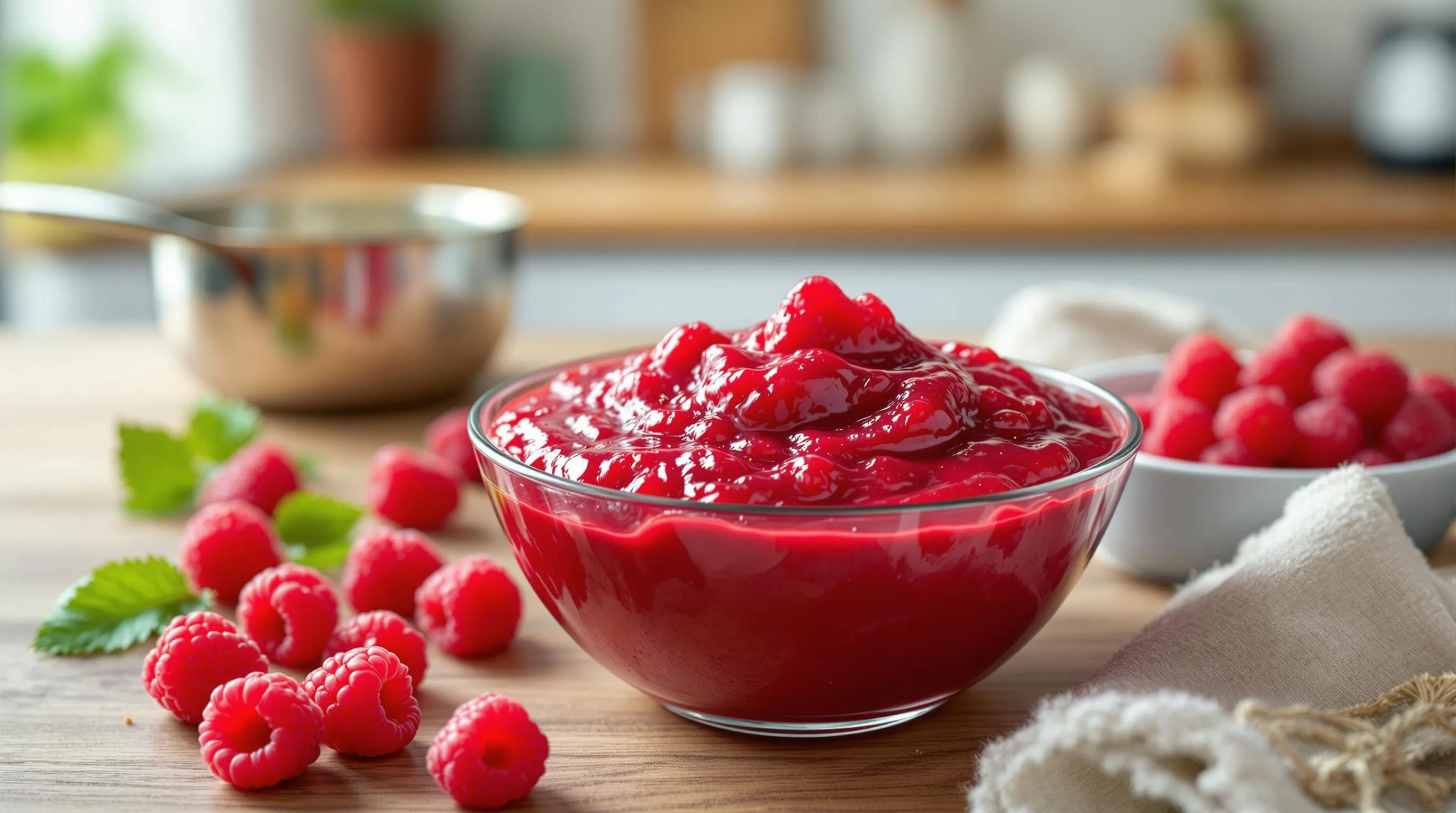
Even with the simplest recipes occasional challenges can arise. Understanding how to fix common issues with your raspberry sauce ensures perfect results every time. Let’s tackle the most frequent problems you might encounter.
Sauce Is Too Thin
Your raspberry sauce should coat the back of a spoon with a silky consistency. If it’s running off like water you have several options to thicken it:
- Continue simmering the sauce for 3-5 additional minutes to reduce excess liquid
- Add 1 teaspoon cornstarch mixed with 1 tablespoon cold water (create a slurry first)
- Blend in 1-2 tablespoons of chia seeds which naturally thicken as they absorb liquid
- Allow the sauce to cool completely as it will naturally thicken at room temperature
Remember that overcooking can diminish the fresh raspberry flavor so monitor closely when reducing.
Sauce Is Too Thick
A sauce that’s too thick won’t pour smoothly over your desserts. Fix this issue by:
- Stirring in 1-2 tablespoons of water while the sauce is warm
- Add a splash of fruit juice (orange or apple work well) for extra flavor
- Mix in additional lemon juice in ½ teaspoon increments
- Gently warm the sauce while adding liquid until you reach desired consistency
Test thickness by lifting your spoon and watching how the sauce drips back into the pan.
Too Many Seeds
The natural seeds in raspberries can be texturally off-putting for some. Address this by:
- Strain the sauce through a finer mesh sieve
- Press more gently when straining to avoid pushing seeds through
- Double-strain for an ultra-smooth result
- Use a food mill with the finest disc attachment if available
For those who prefer maximum smoothness consider straining twice with a progressively finer mesh.
Sauce Is Too Tart
Raspberries naturally vary in sweetness. If your sauce makes you pucker:
- Add sugar in 1 tablespoon increments until balanced
- Try honey or maple syrup for different flavor profiles
- Mix in a pinch of salt to balance acidity without adding sweetness
- Add ¼ teaspoon vanilla extract to round out flavors
Always taste after each addition to avoid oversweetening your sauce.
Sauce Developed Mold
If your sauce has been stored too long or improperly it may develop mold. Unfortunately you must:
- Discard the entire batch immediately
- Never scrape off mold and use the remainder as spores penetrate the entire sauce
- Prevent future issues by using clean utensils and containers
- Store in smaller portions if you won’t use it all within a week
Proper storage techniques significantly extend the shelf life of your raspberry sauce.
Sauce Separated During Storage
Separation is normal but easily fixed:
- Gently warm the sauce over low heat
- Whisk vigorously to reincorporate all components
- Add a tiny amount (¼ teaspoon) of cornstarch slurry if persistent
- Cool completely before returning to storage
The natural pectins in raspberries usually help maintain consistency but temperature fluctuations can cause separation.
Burned Sauce
A scorched sauce develops bitter undertones. If you’ve caught it early:
- Immediately pour the sauce into a clean pan stopping before you reach the burned bottom
- Add fresh ingredients to dilute any transferred burnt flavor
- Increase sweetener slightly to mask mild burning
- Add a drop of pure almond extract which can mask slight burnt notes
Prevention works best here by using low heat and stirring frequently during cooking.
The Perfect Raspberry Sauce Every Time
Creating this ruby-red raspberry sauce is truly a game-changer for your kitchen repertoire. With just a handful of ingredients and minimal effort you’ll have an impressive dessert enhancement that’s ready to elevate everything from morning pancakes to evening ice cream treats.
Remember that this sauce can be customized to your taste preferences—adjust the sweetness adjust the thickness or add your own flavor twists. Whether you choose fresh berries in summer or rely on frozen raspberries year-round the result is equally delightful.
Store your creation properly and you’ll have this versatile sauce ready whenever inspiration strikes. Your homemade raspberry sauce isn’t just a recipe—it’s a simple luxury that transforms ordinary moments into something special.

